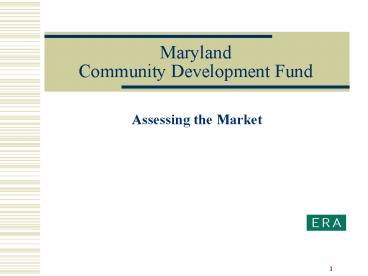Maryland Community Development Fund - PowerPoint PPT Presentation
1 / 21
Title:
Maryland Community Development Fund
Description:
Employment Land Demand. Buying Power. Commercial Demand. Housing ... Low, Mod, Mid Tracts in Baltimore Metro. 15. Low, Mod, Mid Tract in Maryland's DC Metro ... – PowerPoint PPT presentation
Number of Views:35
Avg rating:3.0/5.0
Title: Maryland Community Development Fund
1
MarylandCommunity Development Fund
- Assessing the Market
2
Maryland Fund Targeted Goals
- Affordable housing for workforce populations,
closer to jobs - Mixed-use, mixed-income transit-oriented
development - Inclusionary and balanced community policies
- Regeneration of low-mod and urban communities
- Housing
- Job places
- Commercial services
3
Address Market Imperfections
- Risk bias in markets
- Geographic areas
- Price points
- Transaction size
- Land use/development types
- High transaction costs for return and volume
- Lack of market knowledge
- Redevelopment
- Brownfields/greyfields
- Tenant/buyer financial sophistication
- Inexperienced, undercapitalized developers
4
What Are Investors Financial Goals?
- Rate of return hurdles
- Exit strategy for capital
- Double-bottom line returns
- Sufficient deal flow
5
Market Fundamentals
- Economic base and growing industry clusters
- Job generation by location and wage
- Economic shed
- Household formation by income, type tenure
- Commercial buying power
- Development trends performance
- Quality of existing stock
6
Market Analysis Framework Start with Region
Employment Land Demand
Jobs
Supportable Households by Type
Buying Power
Commercial Demand
Migration
Housing Demand
Changing Demographics
7
Target Area Capture
Regional Demand
Capture
Aggregate Value
Equity Demand
8
Maryland Economies
- Baltimore City
- Anne Arundel County
- Baltimore County
- Howard County
- Montgomery County
- Prince Georges County
- Balance of State
9
Capture Rate Factors
- Regional growth patterns
- Product segmentation
- Existing share of total demand vs. share of
recent growth - Competition their future capacity
- Comparables performance
- Infrastructure, services, and amenities
- Location, location, location
10
Opportunities in Low/Mod Markets
11
Economics Research Associates
Lower Average Incomes
12
Economics Research Associates
But Comparable Middle-Incomes
13
Economics Research Associates
Translates Into Sizeable Buying Power
14
Low, Mod, Mid Tracts in Baltimore Metro
15
Low, Mod, Mid Tract in Marylands DC Metro
16
Low, Mod, Mid Tracts in MD
17
Market Influences Policy Environment
- Does planning policy direct growth to core areas?
- Are regional transportation plans linking jobs to
workforce? - Is government investment supportive?
- Does land use policy support desired development?
- Are communities supportive?
18
Market Influences Development Capacity
- Are there capable developers?
- Are there other equity and debt financing sources
to leverage? - Is land available and at a feasible cost?
- Is funds cost of capital competitive?
19
Tale of Two Markets
- Growth Region
- Job growth
- Strong household formation
- Regional supply shortage
- Growing aggregate buying power
- Public capital for facilities and services
- Stable or Declining Region
- Limited or negative job growth
- Few net new households
- Regional supply surplus
- Stable or declining buying power
- Lack of public capital for facilities and services
20
Tale of Two Markets
- Growth Region
- Direct growth
- Serve emerging niches
- Add improve stock
- Re-cycled housing supported
- Demand supports new supply
- absorption and appreciation
- Stable or Declining Region
- Abate dis-investment
- Serve unmet preferences
- Replace improve stock
- Limits to re-cycling housing
- New supply redirects demand
- winners and losers
21
Potential Equity Demand































